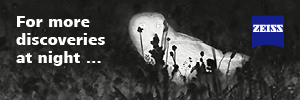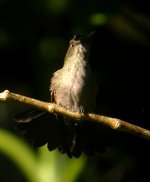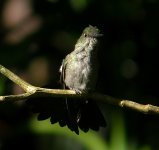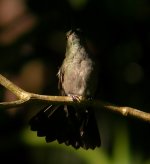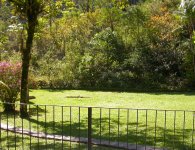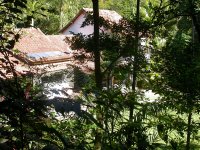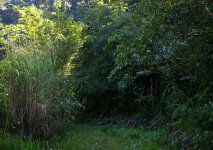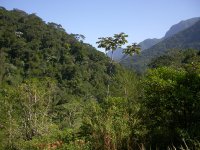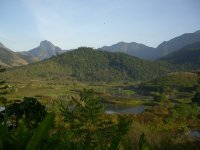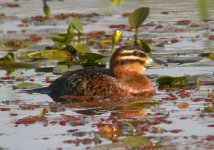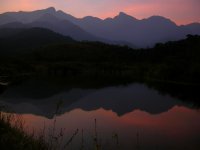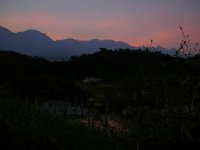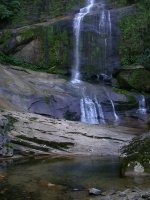
Day Seven: 18th July
Today I got away from the forests with a trip to the seaside. One of the excursions run from Serra dos Tucanos goes to the salt pans and restinga at Praia Seca to the east of Rio. The main aim is to see the very rare Restinga Antwren but there's potential for a variety of other species.
Quite a big party headed south in the minibus and the weather was just right for the seaside, clear and sunny. It was a long drive but after a couple of hours we arrived by a large lagoon. There weren't actually many birds on the lake itself but more was happening in the fields adjacent. Most impressive were a pair of Aplomado Falcons perched up in a dead tree. Parties of Brown-chested Martins and White-rumped Swallows darted over the long grass and a punky looking Guira Cuckoo sat up in the distance.
We then moved onto some muddy salt pans nearby. It was good to be watching a few waders after all the elusive forest species. Small numbers of Greater and Lesser Yellowlegs were paddling about and, at the back of the pans, plenty of White-cheeked Pintails were resting. Overhead the occasional Roseate Spoonbill would drift. As well as the usual egrets, a dark Little Blue Heron was about and a huge Ringed Kingfisher looked about the size of a heron as it flew into the pans. There were some good passerines too: a Yellow-bellied Elaenia and a White-browed Blackbird, looking good with its bright crimson breast. A couple of Yellowish Pipits were seen furtively moving through the grass - looking and sounding much more familiar to a Scottish birder than many of the other other Brazilian passerines. In some distant trees a couple of White Woodpeckers, striking looking open-country woodies, were scoped.
We continued on until we arrived at a beach front car park next to an area of restinga. Restinga is the name given to the scrubby woodland - strangely reminiscent of parts of the East Anglian coast - that's found right next to the sea and, because of its position, it has come under great threat in recent decades as more and more people build beach front properties. Large signs in Portuguese warned anyone of the consequences of damaging the protected remnant that we were about to explore, although one wonders how long this protection will last. Andy suggested to us that Restinga Antwren was a particularly good bird to see because it's very likely to be extinct within a few decades.
Before entering into the restinga, we had a quick seawatch. Offshore there were plenty of Brown Boobies in various plumages moving, along with Magnificent Frigatebirds and a few confusing yellow-billed terns. These were the much talked about Cayenne Terns, similar to Sandwich Terns but with bright yellow bills and slightly paler looking wings. A Cattle Tyrant, a terrestrial kingbird, was hopping about the car park despite the absence of large bovine ruminants. More surprising, but less new, was a Barn Swallow flying purposefully along the shore.
Initially it proved hard to see very much in the restinga, apart from the many lizards that rustled over dry ground. A few Creamy-bellied Thrushes were tucking into berries and a group of White-collared Swifts screamed overhead. In some trees were a small group of Plain-breasted Ground Doves. A Lesser Yellow-headed Vulture, very like a Turkey Vulture, drifted low over the marshes, behaviour that's supposed to be a good distinguishing feature of this species. We had a few goes at playing recordings of Restinga Antwren and eventually one responded but didn't show itself clearly, as we peered into the murk of its dense scrubby habitat.
We decided to spend some more time looking through the waders on the saltpans and here there was quite a good selection, including the ubiquitous Ruddy Turnstones. Is there any coastal area on Earth where you don't commonly get this species? If there is, I've not been there. More novel were the dinky Collared Plovers, scattered amongst the migrant Semipalmated Plovers from North America. A few Least Terns were sailing over the lakes.
We decided to have one last tilt at the antwren and Andy began playing a recording on the corner of some scrub near the saltpans. Happily, we were soon rewared and a male Restinga Antwren moved into a relatively open area of canopy. Here it remained for a couple of minutes giving fantastic views at just a few metres range. This wasn't just a rare bird, it was a real beauty too - jet black with a long tail, white spotted wing coverts and undertail and a brilliant red eye. In the same bush I managed to get some good if brief views of another scarce endemic, a Sooretama Slaty Antshrike - a greyish male similar to the more common Variable Antshrike. Finally, on our walk back to the van, we got some great views of another restinga speciality: a Hangnest Tody-tyrant. The books tend to say this bird is quite non-descript but I was impressed at how bright green it was, almost like some of the lovelier Phylloscopus warblers.
After a big lunch at a local cafe, we headed sleepily back to the lodge. A very fine day, although it looked as if we might miss out until quite late on. The next day, I'd be back in the forest.
Today I got away from the forests with a trip to the seaside. One of the excursions run from Serra dos Tucanos goes to the salt pans and restinga at Praia Seca to the east of Rio. The main aim is to see the very rare Restinga Antwren but there's potential for a variety of other species.
Quite a big party headed south in the minibus and the weather was just right for the seaside, clear and sunny. It was a long drive but after a couple of hours we arrived by a large lagoon. There weren't actually many birds on the lake itself but more was happening in the fields adjacent. Most impressive were a pair of Aplomado Falcons perched up in a dead tree. Parties of Brown-chested Martins and White-rumped Swallows darted over the long grass and a punky looking Guira Cuckoo sat up in the distance.
We then moved onto some muddy salt pans nearby. It was good to be watching a few waders after all the elusive forest species. Small numbers of Greater and Lesser Yellowlegs were paddling about and, at the back of the pans, plenty of White-cheeked Pintails were resting. Overhead the occasional Roseate Spoonbill would drift. As well as the usual egrets, a dark Little Blue Heron was about and a huge Ringed Kingfisher looked about the size of a heron as it flew into the pans. There were some good passerines too: a Yellow-bellied Elaenia and a White-browed Blackbird, looking good with its bright crimson breast. A couple of Yellowish Pipits were seen furtively moving through the grass - looking and sounding much more familiar to a Scottish birder than many of the other other Brazilian passerines. In some distant trees a couple of White Woodpeckers, striking looking open-country woodies, were scoped.
We continued on until we arrived at a beach front car park next to an area of restinga. Restinga is the name given to the scrubby woodland - strangely reminiscent of parts of the East Anglian coast - that's found right next to the sea and, because of its position, it has come under great threat in recent decades as more and more people build beach front properties. Large signs in Portuguese warned anyone of the consequences of damaging the protected remnant that we were about to explore, although one wonders how long this protection will last. Andy suggested to us that Restinga Antwren was a particularly good bird to see because it's very likely to be extinct within a few decades.
Before entering into the restinga, we had a quick seawatch. Offshore there were plenty of Brown Boobies in various plumages moving, along with Magnificent Frigatebirds and a few confusing yellow-billed terns. These were the much talked about Cayenne Terns, similar to Sandwich Terns but with bright yellow bills and slightly paler looking wings. A Cattle Tyrant, a terrestrial kingbird, was hopping about the car park despite the absence of large bovine ruminants. More surprising, but less new, was a Barn Swallow flying purposefully along the shore.
Initially it proved hard to see very much in the restinga, apart from the many lizards that rustled over dry ground. A few Creamy-bellied Thrushes were tucking into berries and a group of White-collared Swifts screamed overhead. In some trees were a small group of Plain-breasted Ground Doves. A Lesser Yellow-headed Vulture, very like a Turkey Vulture, drifted low over the marshes, behaviour that's supposed to be a good distinguishing feature of this species. We had a few goes at playing recordings of Restinga Antwren and eventually one responded but didn't show itself clearly, as we peered into the murk of its dense scrubby habitat.
We decided to spend some more time looking through the waders on the saltpans and here there was quite a good selection, including the ubiquitous Ruddy Turnstones. Is there any coastal area on Earth where you don't commonly get this species? If there is, I've not been there. More novel were the dinky Collared Plovers, scattered amongst the migrant Semipalmated Plovers from North America. A few Least Terns were sailing over the lakes.
We decided to have one last tilt at the antwren and Andy began playing a recording on the corner of some scrub near the saltpans. Happily, we were soon rewared and a male Restinga Antwren moved into a relatively open area of canopy. Here it remained for a couple of minutes giving fantastic views at just a few metres range. This wasn't just a rare bird, it was a real beauty too - jet black with a long tail, white spotted wing coverts and undertail and a brilliant red eye. In the same bush I managed to get some good if brief views of another scarce endemic, a Sooretama Slaty Antshrike - a greyish male similar to the more common Variable Antshrike. Finally, on our walk back to the van, we got some great views of another restinga speciality: a Hangnest Tody-tyrant. The books tend to say this bird is quite non-descript but I was impressed at how bright green it was, almost like some of the lovelier Phylloscopus warblers.
After a big lunch at a local cafe, we headed sleepily back to the lodge. A very fine day, although it looked as if we might miss out until quite late on. The next day, I'd be back in the forest.



